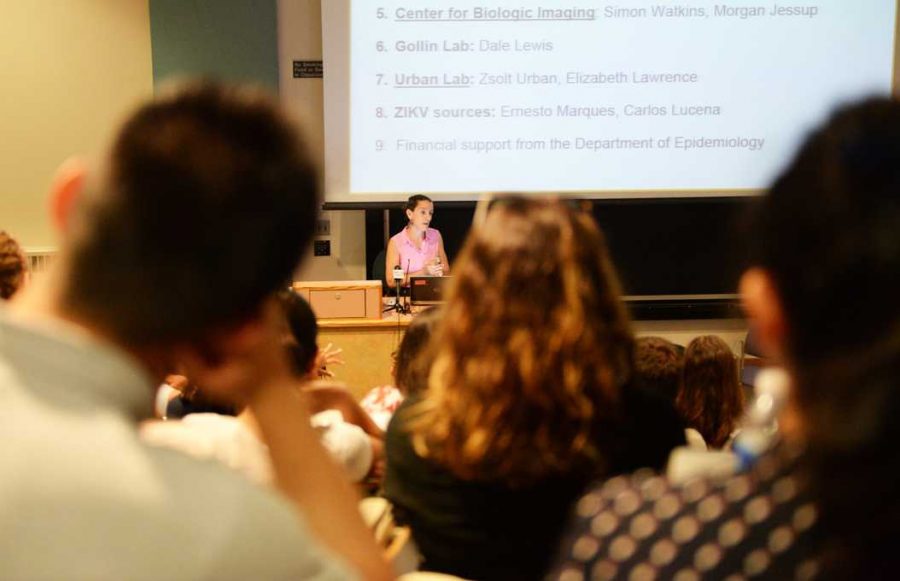Amidst the public’s rising fear of the Zika virus, Pitt researchers are on the forefront of those digging for explanations and cures.
On Thursday afternoon, researchers from Pitt and from the Fundação Oswaldo Cruz Foundation, also known as FIOCRUZ, a Brazilian biomedical research and development institution, presented the first results of their preliminary research into the Zika virus.
The researchers are following different lines of investigation toward understanding the mechanisms and processes the virus uses to wreak havoc on the human body. Although the research presented on Thursday was still in its early stages, Isabelle Viana, a postdoctoral researcher in the Pitt Graduate School of Public Health, is confident that her yellow fever vaccine can be modified for use against the Zika virus.
Viana has created a DNA-based vaccine –– originally used for yellow fever –– that can also be used for Zika. The vaccine forces cells to present the virus’ identifying molecules so the immune system has a chance to recognize the virus and build resistance.
Viana’s vaccine, though only experimental, would enable the immune system to more quickly shut down the Zika virus upon future exposure.
According to Viana, the biggest technological barrier up to this point for a Zika vaccine is that the body may not expose the immune system to the virus’ fingerprint, preventing it from being able to identify and attack the virus in the future.
“We all know that we need a vaccine against [the] Zika virus,” Viana said. “However, the knowledge gap against the Zika virus infection hampers the development of traditional immunization strategies. We believe that we have a potential solution for that.”
Zika, a virus spread through sexual contact or mosquito bites, typically causes only mild symptoms in adults, but can cause severe brain defects in infants whose mothers contracted the virus during pregnancy. In late July, the first cases of the virus borne in the United States were diagnosed in Florida.
The partnership between Pitt and FIOCRUZ led to a program called Cura Zika, which provides rapid funding from Pitt’s Graduate School of Public Health and schools of the health sciences, in addition to pledge money. The funds are used to accelerate time-sensitive Zika research into its later stages. Cura Zika distributed its first round of funding to six research labs, in amounts ranging from $30,000 to $40,000. The funded labs must submit final reports on their projects by Sept. 1, 2017.
“It’s a multidisciplinary problem,” said Ernesto Marques, professor of infectious disease and microbiology at Pitt and FIOCRUZ and the driving force behind the collaboration between Pitt and Brazil on the Zika initiative.
At this point, Congress has authorized funding for Zika research, but it hasn’t actually allocated any funds yet. Until the federal funding arrives, Pitt is filling the gap with private donors and University money, according to Donald Burke, dean of the Pitt School of Public Health.
An anonymous donor gave an initial startup grant of $200,000 earlier this year, which Pitt matched, and then the donor vowed to raise the total to $1 million in support of Pitt’s efforts to address the Zika crisis. This money has so far funded six different labs across Pitt and FIOCRUZ, who presented their early-stage results Thursday afternoon.
As Viana is gunning for a vaccine, Vishwajit Nimgaonkar –– a Pitt professor of psychiatry and human genetics –– is focusing on learning how the Zika virus attacks the brain.
“We feel that there might be actually other risk factors in addition to Zika that are responsible for the mischief in the brain,” Nimgaonkar said.
Risk factors include prior exposure to other diseases — particularly a common tropical mosquito-borne illness called dengue fever, which was emphasized in Thursday’s talks — and genetics, which Nimgaonkar’s lab at Western Psychiatric Institute and Clinic of UPMC is actively investigating.
Nimgaonkar’s lab is working not only on how Zika contributes to cell death but also how Zika impacts neuronal differentiation, the process by which immature neuronal cells develop into a functioning nervous system. His lab is studying this process by growing neurons under various conditions, including exposure to the Zika virus and observing how these neurons develop.
Researchers believe Zika is particularly harmful in the first trimester of pregnancy, as this is when the fetal brain is developing. Nimgaonkar is trying to figure out why the virus is so harmful at this juncture — whether because the virus prevents neurons from differentiating or because the virus kills them.
While the researchers at Thursday afternoon’s panels addressed everything from molecular pathways to neuronal development, nearly every speaker stressed the need to work together in the fight against Zika.
“We are very interested in trying to build bridges to Brazil,” Nimgaonkar said. “And we are hoping we can continue working on this collaboration beyond the life of the grant application.”


